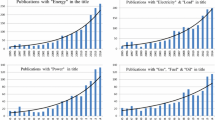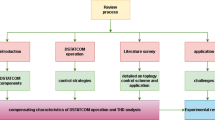Abstract
Any disturbance in the grid affects the real and reactive power outputs of the generators. The capability of producing real and reactive power is usually known as capability curve. The conventional static capability uses predefined operating constraints pertaining to mechanical power, rotor angle, terminal voltage, rated power factor and field voltage of the generator. However, the generators connected to the grid have dynamic operating states which can be predicted in real-time using data from phasor measurement unit (PMU). The generator transient stability is important from power system stability point of view because tripping of generators due to instability creates cascading effects. The present work proposes the real-time monitoring of dynamic state of generators through dynamic capability curve using rotor angle. The rotor angles are not directly measured by the PMUs and hence are being estimated using extended Kalman filter. Values of rotor angle are used for principal component analysis (PCA) for identifying coherent and non-coherent generators. Any non-coherent generator beyond the dynamic capability curve limits is a clear indication of eventually becoming an unstable generator and has been termed as most critical generator. The proposed scheme employs multiple artificial neural network to incorporate inference from dynamic capability curve as well as that from PCA for identifying critical generators as well as predicting the degree of criticality of marginally critical generators within a time window of 12 cycles after occurrence of fault. The simulation results using case studies from IEEE-39 bus system validates the efficacy of the proposed methodology.














Similar content being viewed by others
References
Murthy C, Mishra A, Ghosh D, Roy DS, Mohanta DK (2014) Reliability analysis of phasor measurement unit using hidden markov model. IEEE Syst J 8(4):1293–1301. https://doi.org/10.1109/JSYST.2014.2314811
Appasani B, Mohanta DK (2018) A review on synchrophasor communication system: communication technologies, standards and applications. Prot Control Mod Power Syst 3(1):37. https://doi.org/10.1186/s41601-018-0110-4
Babu R, Bhattacharyya B (2016) Optimal allocation of phasor measurement unit for full observability of the connected power network. Int J Electr Power Energy Syst 79:89–97. https://doi.org/10.1016/j.ijepes.2016.01.011
Appasani B, Mohanta DK (2017) Optimal placement of synchrophasor sensors for risk hedging in a smart grid. IEEE Sens J 17(23):7857–7865. https://doi.org/10.1109/JSEN.2017.2742524
Mohanta DK, Murthy C, Sinha Roy D (2016) A brief review of phasor measurement units as sensors for smart grid. Electr Power Compon Syst 44(4):411–425. https://doi.org/10.1080/15325008.2015.1117538
Usman MU, Faruque MO (2019) Applications of synchrophasor technologies in power systems. J Mod Power Syst Clean Energy 7(2):211–226. https://doi.org/10.1007/s40565-018-0455-8
Shariati O, Mohd Zin AA, Khairuddin A, Aghamohammadi MR (2014) Development and implementation of neural network observers to estimate synchronous generator’s dynamic parameters using on-line operating data. Electr Eng 96(1):45–54. https://doi.org/10.1007/s00202-012-0274-2
W Fan, Y Liao (2012) Impacts of flickers, harmonics and faults on synchronous generator operations. In: Proceedings of the 2012 44th Southeastern Symposium on System Theory (SSST), 220–225, doi: https://doi.org/10.1109/SSST.2012.6195136.
Chen H, Zhao T (2020) Modeling power loss during blackouts in China using non-stationary generalized extreme value distribution. Energy. https://doi.org/10.1016/j.energy.2020.117044
Vrana TK, Hille C (2011) A novel control method for dispersed converters providing dynamic frequency response. Electr Eng 93(4):217–226. https://doi.org/10.1007/s00202-011-0210-x
Dwivedi A, Mallikarjuna B, Pal D, Reddy MJB, Mohanta DK (2019) A real-time synchrophasor-based zone-3 supervision of distance relays under load encroachment condition. IEEE Syst J 13(4):4227–4235. https://doi.org/10.1109/JSYST.2018.2890475
Kimbark E (1995) Power system stability. John Wiley, Hoboken
Grainger W, Stevenson JJ (1994) Power system analysis, vol 5. McGraw-Hill, New York
Scruggs JT, Mili L (2001) Dynamic gradient method for PEBS detection in power system transient stability assessment. Int J Electr Power Energy Syst 23(2):155–165. https://doi.org/10.1016/S0142-0615(00)00038-7
Willems J, Willems J (1970) The application of lyapunov methods to the computation of transient stability regions for multimachine power systems. IEEE Trans Power Appar Syst 689(5):795–801. https://doi.org/10.1109/TPAS.1970.292636
Yang H, Zhang W, Shi F, Xie J, Ju W (2019) PMU-based model-free method for transient instability prediction and emergency generator-shedding control. Int J Electr Power Energy Syst 105:381–393. https://doi.org/10.1016/j.ijepes.2018.08.031
Huang D, Chen Q, Ma S, Zhang Y, Chen S (2018) Wide-area measurement—based model-free approach for online power system transient stability assessment. Energies 11(4):958. https://doi.org/10.3390/en11040958
Ji L, Wu J, Zhou Y, Hao L (2016) Using trajectory clusters to define the most relevant features for transient stability prediction based on machine learning method. Energies 9(11):898. https://doi.org/10.3390/en9110898
Ariff MAM, Pal BC (2016) Adaptive protection and control in the power system for wide-area blackout prevention. IEEE Trans Power Deliv 31(4):1815–1825. https://doi.org/10.1109/TPWRD.2016.2518080
Hashiesh F, Mostafa HE, Khatib A-R, Helal I, Mansour MM (2012) An intelligent wide area synchrophasor based system for predicting and mitigating transient instabilities. IEEE Trans Smart Grid 3(2):645–652. https://doi.org/10.1109/TSG.2012.2187220
Azman MS, Isbeih Y, El Moursi MS, Elbassioni K (2020) A Unified Online Deep Learning Prediction Model for Small Signal and Transient Stability. IEEE Trans Power Syst. https://doi.org/10.1109/TPWRS.2020.2999102
Aghamohammadi MR, Abedi M (2018) DT based intelligent predictor for out of step condition of generator by using PMU data. Int J Electr Power Energy Syst 99:95–106. https://doi.org/10.1016/j.ijepes.2018.01.001
Siddiqui SA, Verma K, Niazi KR, Fozdar M (2018) Real-time monitoring of post-fault scenario for determining generator coherency and transient stability through ANN. IEEE Trans Ind Appl 54(1):685–692. https://doi.org/10.1109/TIA.2017.2753176
Jamei M et al (2020) Phasor measurement units optimal placement and performance limits for fault localization. IEEE J Sel Areas Commun 38(1):180–192. https://doi.org/10.1109/JSAC.2019.2951971
Almasabi S, Mitra J (2019) A fault-tolerance based approach to optimal PMU placement. IEEE Trans Smart Grid 10(6):6070–6079. https://doi.org/10.1109/TSG.2019.2896211
Babu R, Bhattacharyya B (2019) Strategic placements of PMUs for power network observability considering redundancy measurement. Measurement 134:606–623. https://doi.org/10.1016/j.measurement.2018.11.001
Kundur NJ, Balu P (1994) Power system stability and control, vol 7. McGraw-Hill, New York
Phadke AG, Thorp JS (2008) Synchronized phasor measurements and their applications. Springer, Boston
Ghahremani E, Kamwa I (2011) Dynamic state estimation in power system by applying the extended kalman filter with unknown inputs to phasor measurements. IEEE Trans Power Syst 26(4):2556–2566. https://doi.org/10.1109/TPWRS.2011.2145396
Ahmadi Jeyed H, Ghaffari A (2019) Nonlinear estimator design based on extended Kalman filter approach for state estimation of articulated heavy vehicle. Proc Inst Mech Eng Part K J Multi-body Dyn 233(2):254–265. https://doi.org/10.1177/1464419318772173
Naseri F, Kazemi Z, Farjah E, Ghanbari T (2019) Fast detection and compensation of current transformer saturation using extended kalman filter. IEEE Trans Power Deliv 34(3):1087–1097. https://doi.org/10.1109/TPWRD.2019.2895802
Gibbs BP (2011) Advanced kalman filtering, least-squares and modeling. John Wiley, Hoboken
Diaz-Alzate A, Candelo-Becerra J, Villa Sierra J (2019) Transient stability prediction for real-time operation by monitoring the relative angle with predefined thresholds. Energies 12(5):838. https://doi.org/10.3390/en12050838
Isbeih YJ, El Moursi MS, Xiao W, El-Saadany E (2019) Generator-based threshold for transient stability assessment. IET Smart Grid 2(3):407–419. https://doi.org/10.1049/iet-stg.2018.0292
Aghamohammadi MR, Tabandeh SM (2016) A new approach for online coherency identification in power systems based on correlation characteristics of generators rotor oscillations. Int J Electr Power Energy Syst 83:470–484. https://doi.org/10.1016/j.ijepes.2016.04.019
Khalkho AM, Kumar Mohanta D (2019) Identification and categorisation of critical synchronous generators for transient stability analysis. In: 2019 IEEE 16th India Council International Conference (INDICON), 1–4, doi: https://doi.org/10.1109/INDICON47234.2019.9030345
Mahto DK, F Kibriya F, Khalkho AM, Mohanta DK (2019) Data driven approach for wide area generator coherency detection using synchrophasor measurements. In: 2019 IEEE Region 10 Symposium (TENSYMP), 771–774, doi: https://doi.org/10.1109/TENSYMP46218.2019.8971101
Ramos GL, Rodrigues GF, Camilo FM, Rego CG (2019) Comparison between statistical and principal component analysis in reduction of near-field FDTD data. IET Microw Antennas Propag 13(13):2315–2318. https://doi.org/10.1049/iet-map.2018.5611
Liu Y, Liu Y, Liu J, Li M, Ma Z, Taylor G (2016) High-performance predictor for critical unstable generators based on scalable parallelized neural networks. J Mod Power Syst Clean Energy 4(3):414–426. https://doi.org/10.1007/s40565-016-0209-4
He Y, Nie S, Liu R, Jiang S, Shi Y, Wan Q (2019) Spatiotemporal information processing emulated by multiterminal neuro-transistor networks. Adv Mater 31(21):1900903. https://doi.org/10.1002/adma.201900903
Patterson DW (1996) Artificial neural networks: theory and applications. Prentice Hall, Singapore
Moré JJ (1978) The levenberg-marquardt algorithm: implementation and theory. Springer, Newyrok, pp 105–116
Canizares C et al (2017) Benchmark models for the analysis and control of small-signal oscillatory dynamics in power systems. IEEE Trans Power Syst 32(1):715–722. https://doi.org/10.1109/TPWRS.2016.2561263
Chakrabarti S, Kyriakides E (2008) Optimal placement of phasor measurement units for power system observability. IEEE Trans Power Syst 23(3):1433–1440. https://doi.org/10.1109/TPWRS.2008.922621
Funding
Funding was provided by Department of Science and Technology, Ministry of Science and Technology (Grant No. F.No.DST/NM-ICPS/MGB /2018)
Author information
Authors and Affiliations
Corresponding author
Additional information
Publisher's Note
Springer Nature remains neutral with regard to jurisdictional claims in published maps and institutional affiliations.
Appendix
Appendix
1.1 Mechanical power input values for generators considered
Rights and permissions
About this article
Cite this article
Khalkho, A.M., Mohanta, D.K. Wide area power system transient stability prediction incorporating dynamic capability curve and generator bus coherency. Electr Eng 103, 1445–1459 (2021). https://doi.org/10.1007/s00202-020-01171-8
Received:
Accepted:
Published:
Issue Date:
DOI: https://doi.org/10.1007/s00202-020-01171-8




